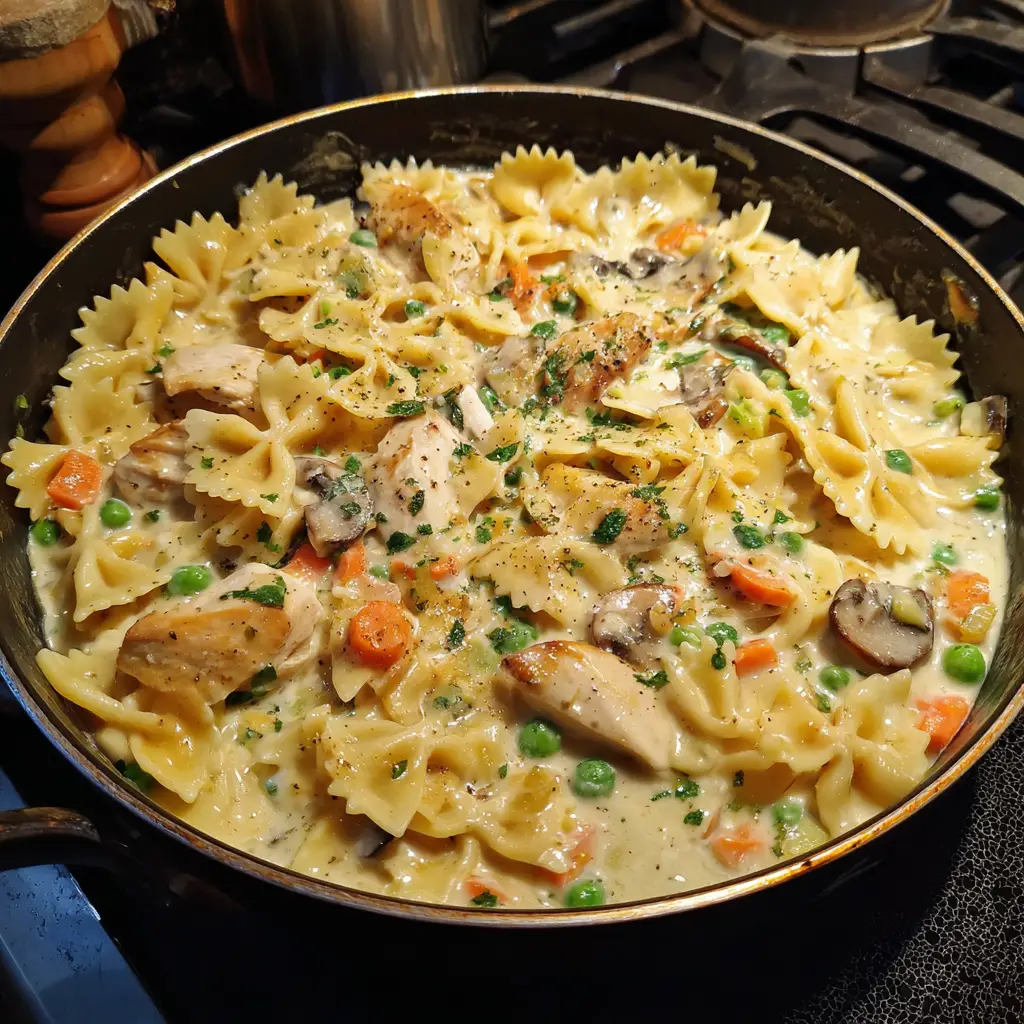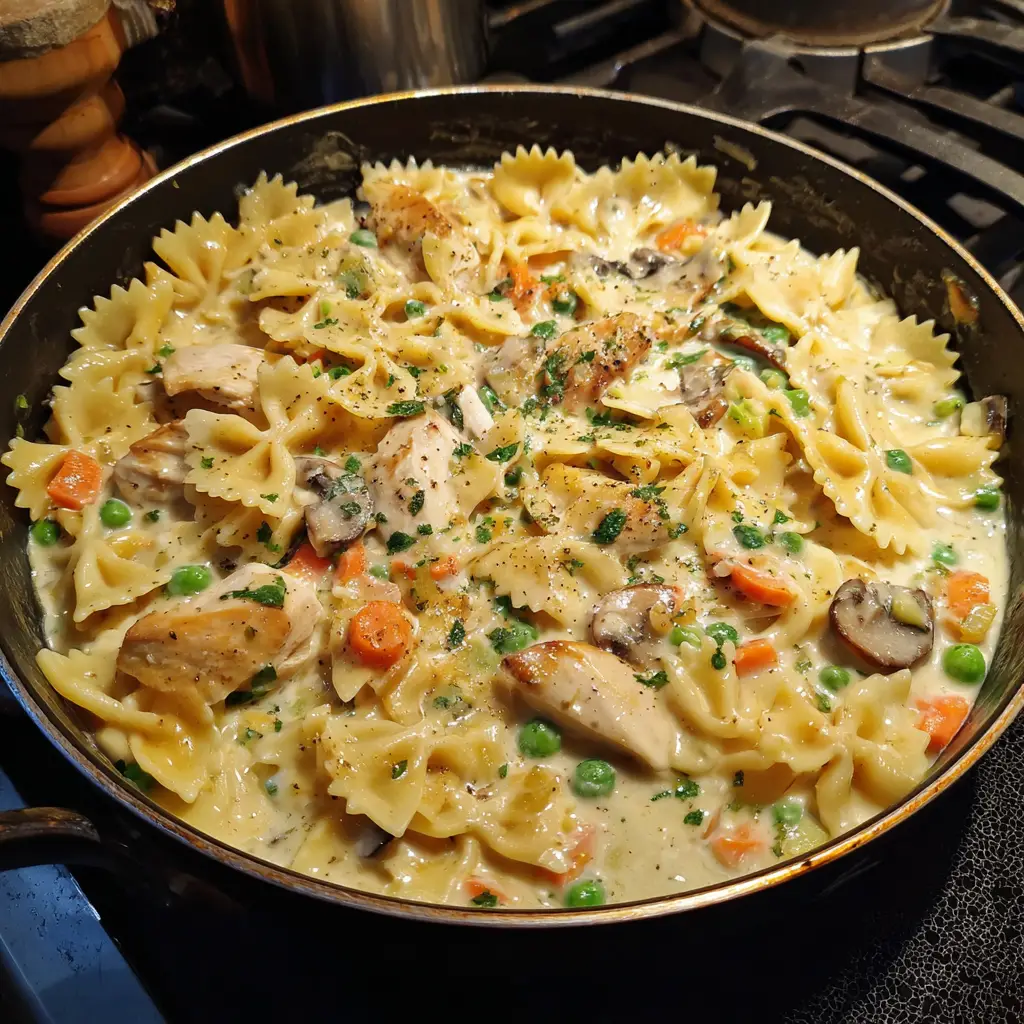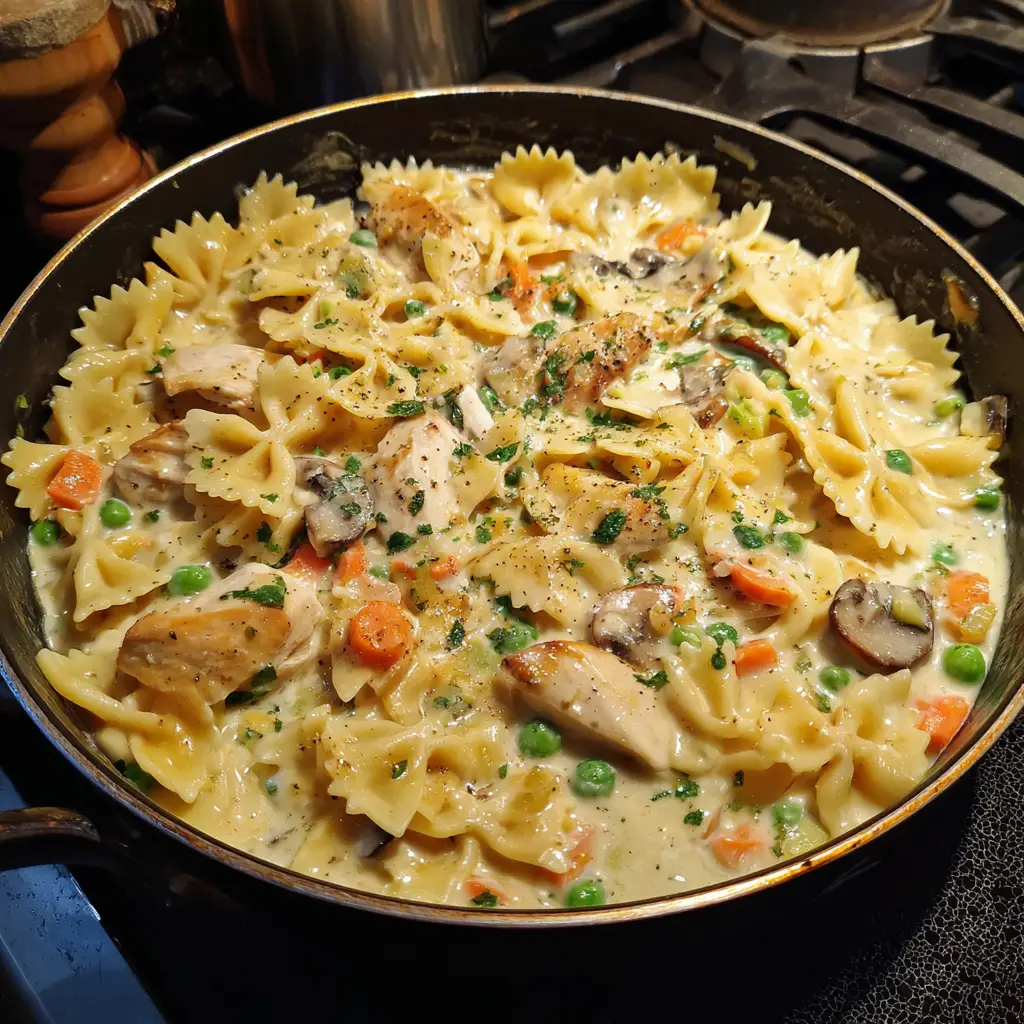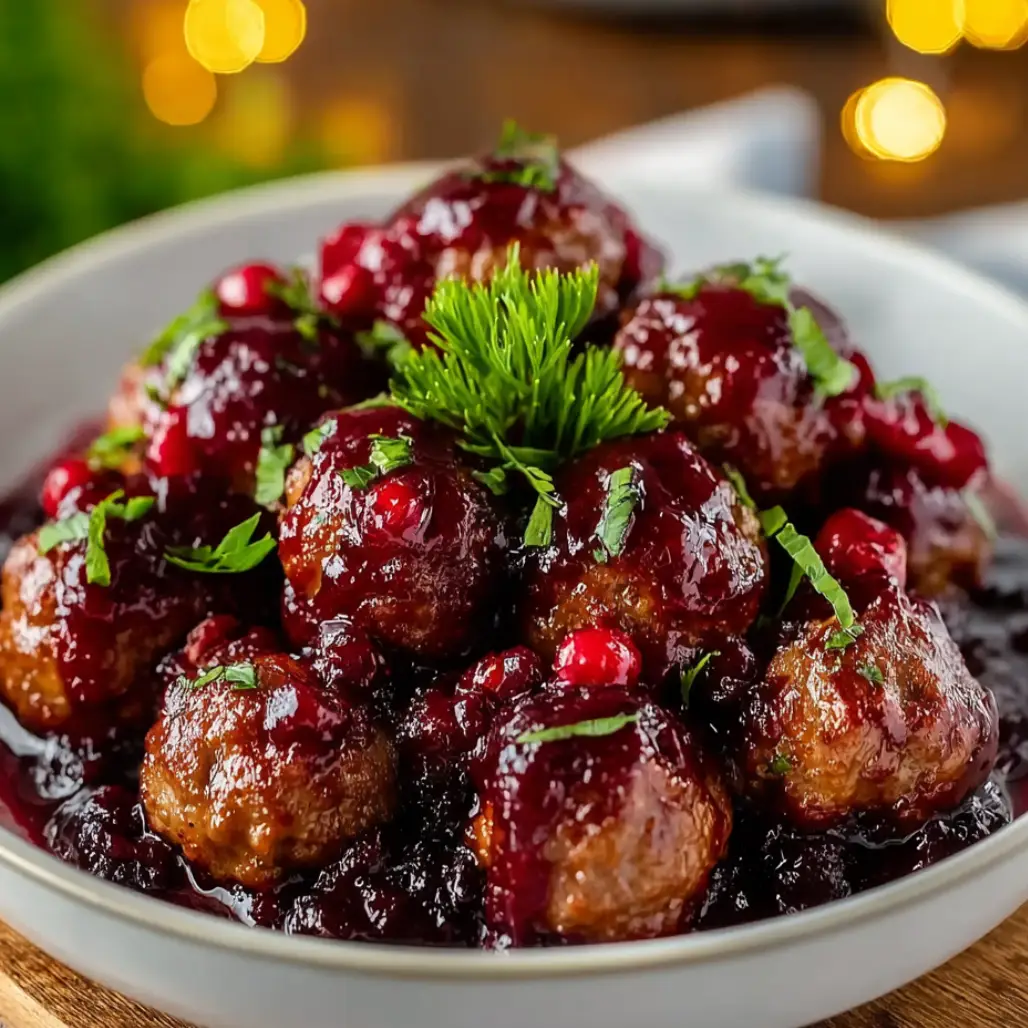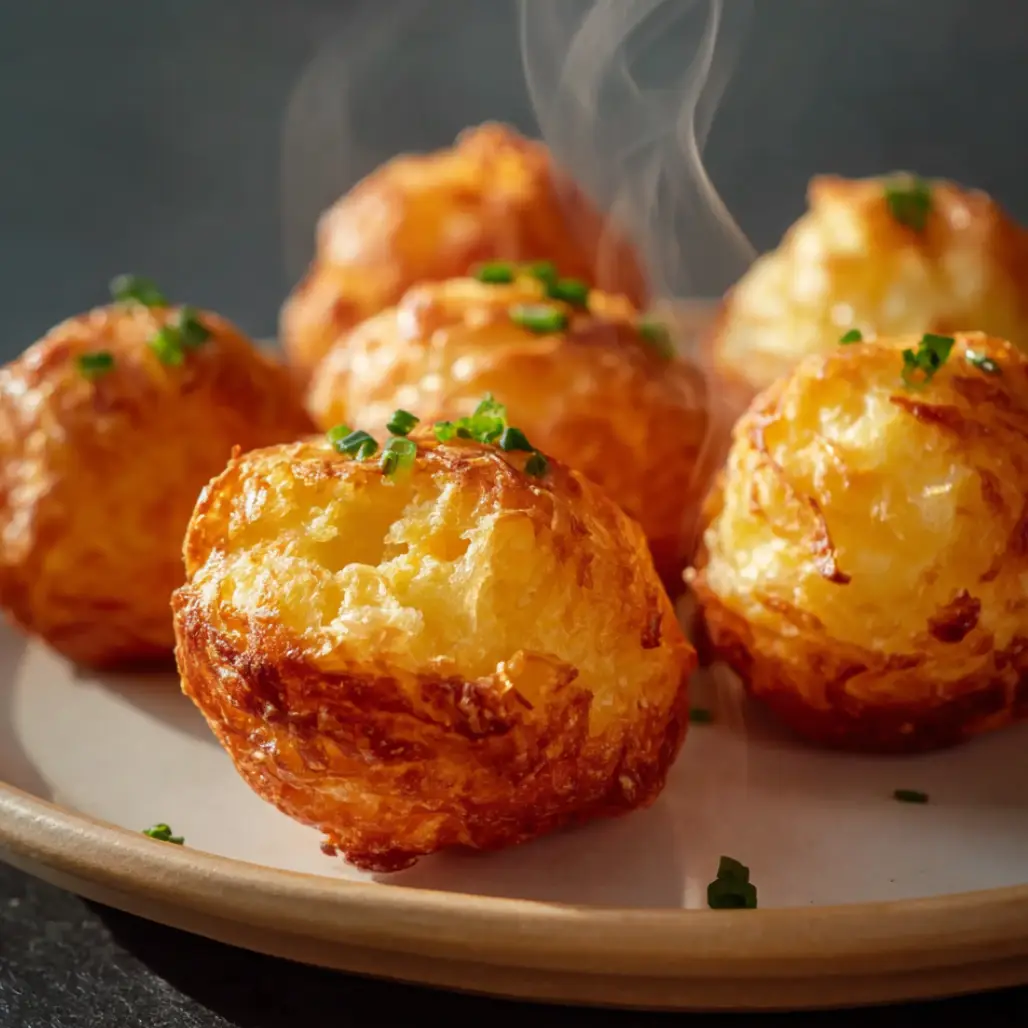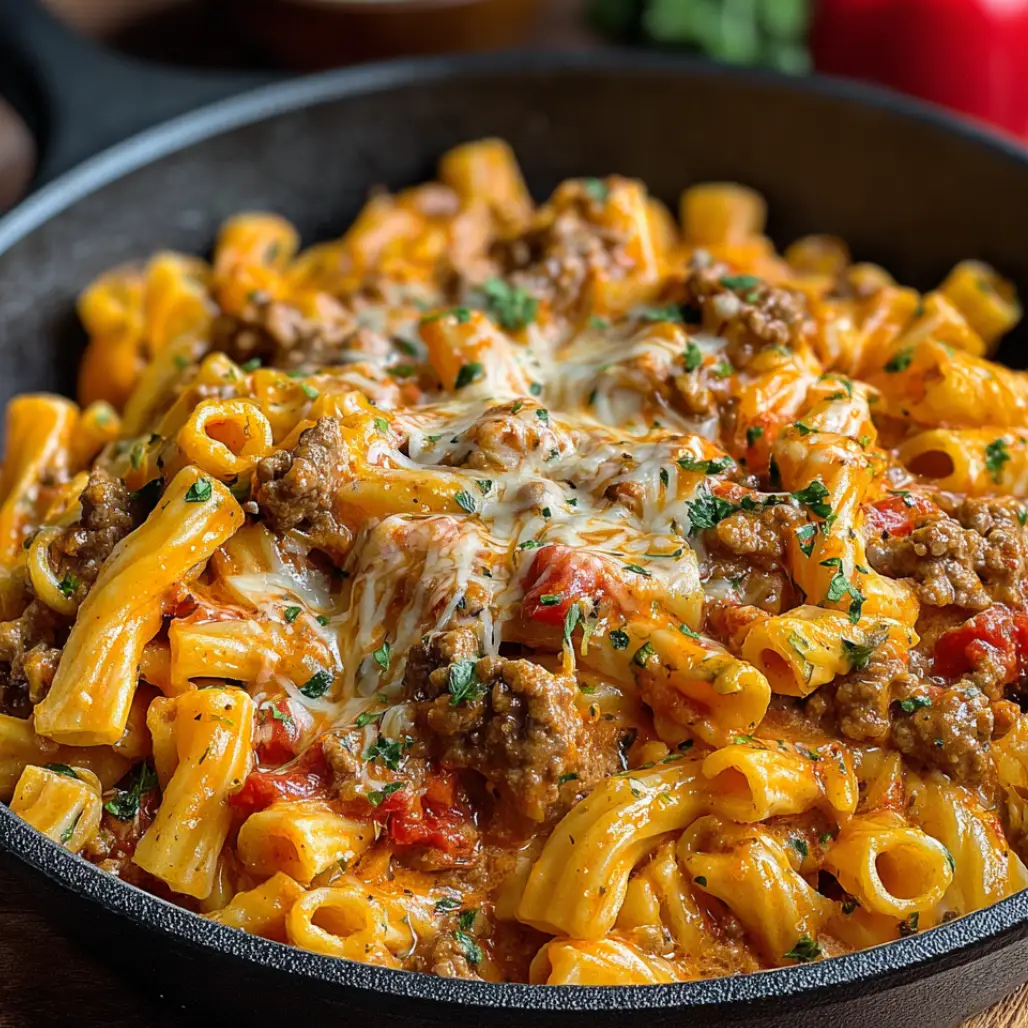| Prep Time | Cook Time | Total Time | Serves |
|---|---|---|---|
| 15 minutes | 30 minutes | 45 minutes | 6 |
Why This Creamy Chicken Pot Pasta Recipe Works
The brilliance of this creamy chicken pot pasta stems from its thoughtful combination of traditional pot pie elements with pasta’s versatility because this fusion creates a dish that maintains all the comforting characteristics of the classic while offering improved convenience and broader appeal to different age groups and preferences. The one-pot cooking method ensures that flavors develop and meld throughout the cooking process because each ingredient contributes to building layers of taste while the pasta absorbs the rich, seasoned cooking liquid that becomes the foundation of the creamy sauce.
Tender chicken pieces provide substantial protein while remaining juicy and flavorful because proper seasoning and cooking techniques prevent dryness while allowing the meat to contribute savory depth to the overall dish. The classic pot pie vegetables including carrots, celery, and onions create the aromatic foundation because these ingredients release their natural sugars and flavors during the cooking process while maintaining enough texture to provide satisfying contrast against the tender pasta.
The creamy sauce develops naturally through careful technique because a flour-based roux thickens the cooking liquid while heavy cream adds richness and smoothness that coats every component beautifully. This method creates a more integrated sauce than simply adding cream at the end because the flour helps stabilize the dairy while preventing separation that could compromise both texture and appearance.
Herb seasoning with thyme and sage captures the essence of traditional pot pie because these aromatic herbs have been associated with comfort cooking for centuries while their earthy, slightly piney flavors complement both chicken and vegetables perfectly. The timing of adding these herbs ensures maximum flavor impact because they have sufficient time to infuse the cooking liquid while retaining their bright, fresh character.
This recipe succeeds because it balances richness with freshness through the addition of bright elements like lemon juice or fresh herbs that prevent the dish from becoming heavy while maintaining the indulgent character that makes comfort food so appealing and satisfying.
Essential Ingredients for Perfect Creamy Chicken Pot Pasta
For the Main Dish:
- 1 1/2 pounds boneless, skinless chicken breasts (cut into 1-inch pieces)
- 12 ounces wide egg noodles (or penne pasta)
- 3 tablespoons butter (divided)
- 1 large onion (diced)
- 3 celery stalks (diced)
- 3 large carrots (diced)
- 4 cloves garlic (minced)
- 1/3 cup all-purpose flour
- 3 cups chicken broth (low-sodium)
- 1 cup heavy cream
- 1 cup frozen peas
- 1 cup frozen corn
For Seasoning:
- 2 teaspoons dried thyme
- 1 teaspoon dried sage
- 1 teaspoon salt (or to taste)
- 1/2 teaspoon black pepper
- 1/4 teaspoon paprika
- 2 tablespoons fresh parsley (chopped, for garnish)
Optional Enhancements:
- 1/2 cup grated Parmesan cheese
- 2 tablespoons olive oil (for cooking chicken)
- 1 bay leaf (for extra flavor)
- 1 tablespoon lemon juice (for brightness)
Creating exceptional creamy chicken pot pasta requires selecting premium ingredients because the simplicity of this one-pot dish means that each component must contribute optimal flavor and texture to achieve the sophisticated comfort food experience that makes this recipe so memorable. Fresh chicken breasts provide the protein foundation because their mild flavor and tender texture work perfectly with the creamy sauce while remaining substantial enough to make this a satisfying main course meal.
Quality pasta serves as more than just a starch component because the right shape and texture help the sauce cling properly while providing the satisfying chewiness that makes each bite complete and fulfilling. Wide egg noodles work exceptionally well because their broad surface area holds sauce beautifully while their rich, eggy flavor complements the overall comfort food character of the dish.
Fresh vegetables create the classic pot pie flavor profile because onions, carrots, and celery form the holy trinity of comfort cooking while providing natural sweetness, aromatic depth, and textural variety that prevents the dish from becoming monotonous. Choose firm, bright vegetables because their quality directly impacts both flavor and visual appeal of the finished dish.
Heavy cream provides the luxurious richness because its fat content creates the smooth, coating sauce that defines this dish while remaining stable during cooking without curdling or separating under heat. The cream also helps meld all flavors together because fat carries flavor compounds and creates the mouthfeel that makes this pasta so satisfying and indulgent.
The Art of Creating Perfect Creamy Chicken Pot Pasta
Mastering the art of creamy chicken pot pasta involves understanding how timing and technique work together to build flavors while maintaining proper textures because this knowledge allows you to create restaurant-quality results in your home kitchen while avoiding common pitfalls that could compromise the dish’s appeal. The process begins with proper mise en place because having all ingredients prepared and measured before cooking ensures smooth execution while preventing overcooking or undercooking that could affect the final texture.
Chicken preparation technique affects both flavor and texture because properly seasoned and cooked chicken contributes savory depth while remaining tender and juicy throughout the cooking process. The size of chicken pieces matters because uniform cuts ensure even cooking while pieces that are too large may not cook through properly and pieces that are too small may become dry and stringy.
Vegetable cooking sequence creates the flavor foundation because cooking aromatics in a specific order allows each ingredient to contribute its best characteristics while building layers of taste that form the backbone of the entire dish. The vegetables should soften and release their flavors without becoming mushy because they need to maintain enough structure to provide textural interest in the finished pasta.
Roux development requires patience and attention because this flour and fat mixture thickens the sauce while providing stability that prevents separation and creates the smooth, creamy consistency that makes this dish so appealing. Proper roux cooking eliminates the raw flour taste because adequate time and heat allow the flour proteins to cook completely while developing the nutty flavor that enhances rather than detracts from the overall taste.
Liquid incorporation technique prevents lumps and ensures smooth sauce development because gradual addition of broth and cream allows the roux to absorb liquids evenly while maintaining the proper consistency that coats pasta beautifully without being too thick or too thin.
Step-by-Step Instructions for Creamy Chicken Pot Pasta
Preparing Ingredients and Equipment
Begin by gathering all ingredients and cutting chicken into uniform 1-inch pieces because consistent sizing ensures even cooking while preventing some pieces from becoming overcooked while others remain underdone. Season the chicken pieces with salt, pepper, and paprika because early seasoning allows the flavors to penetrate the meat while creating a more cohesive taste throughout the finished dish.
Dice all vegetables into similar-sized pieces because uniform cuts promote even cooking while creating an attractive appearance that makes the dish more visually appealing when served. Keep vegetables separate because they will be added at different times during the cooking process to ensure optimal texture and flavor development.
Professional Tip: Use a large, heavy-bottomed pot or Dutch oven because these vessels distribute heat evenly while providing adequate space for all ingredients without overcrowding that could lead to steaming rather than proper browning.
Key Points: Proper preparation prevents rushed cooking because having everything ready allows you to focus on technique and timing rather than scrambling to prepare ingredients while other components are cooking.
Building the Flavor Foundation
Heat one tablespoon of butter in your large pot over medium-high heat because this temperature allows proper browning without burning while creating the flavorful fond that will enhance the overall taste of the dish. Add seasoned chicken pieces in a single layer because overcrowding prevents proper browning while even distribution ensures all pieces cook uniformly.
Cook chicken for 6-8 minutes, turning occasionally, until golden brown on all sides and cooked through because proper browning creates flavor compounds that contribute depth and richness to the final dish. Remove cooked chicken to a plate and set aside because this prevents overcooking while allowing you to build the sauce without the chicken becoming tough or dry.
Professional Tip: Don’t move the chicken too frequently during browning because allowing it to develop a golden crust creates more flavor than constantly stirring or flipping the pieces.
Key Points: Proper browning develops flavor because the Maillard reaction creates complex taste compounds that cannot be achieved through other cooking methods, making this step essential for optimal results.
Creating the Aromatic Vegetable Base
Add remaining butter to the same pot because using the chicken drippings enhances flavor while the additional fat helps cook the vegetables properly without sticking or burning. Add diced onions, carrots, and celery because this classic combination creates the aromatic foundation that defines comfort cooking while providing sweetness and depth.
Cook vegetables for 8-10 minutes, stirring occasionally, until they begin to soften and the onions become translucent because this timing allows the vegetables to release their flavors while maintaining enough texture to provide interest in the finished dish. Add minced garlic during the last minute of vegetable cooking because garlic burns easily and requires less time to develop its aromatic contribution.
Professional Tip: Listen for gentle sizzling throughout the vegetable cooking process because this indicates proper heat level while silence might mean temperature is too low and aggressive bubbling could mean heat is too high.
Key Points: Proper vegetable cooking creates the flavor base because these ingredients release their natural sugars and aromatics that form the foundation for the creamy sauce that follows.
Developing the Creamy Sauce
Sprinkle flour over the cooked vegetables and stir constantly for 2-3 minutes because this creates a roux that will thicken the sauce while cooking out the raw flour taste that could make the finished dish taste chalky or unpleasant. The mixture should bubble gently because this indicates proper heat level for cooking the flour without burning.
Gradually add chicken broth while whisking constantly because slow incorporation prevents lumps while allowing the roux to absorb the liquid evenly and create a smooth base for the creamy sauce. Continue whisking until the mixture is smooth and begins to thicken because proper technique at this stage determines the final texture of your sauce.
Professional Tip: Add liquid gradually and whisk vigorously because rushing this step often results in lumpy sauce that requires straining or starting over to achieve proper smoothness.
Key Points: Proper roux and liquid incorporation creates smooth sauce because gradual addition allows the flour mixture to absorb liquids evenly while preventing the separation that could ruin the dish’s texture.
Combining and Finishing the Dish
Add heavy cream, thyme, sage, and additional seasonings because these ingredients complete the flavor profile while the cream creates the rich, luxurious texture that makes this dish so satisfying and indulgent. Bring the mixture to a gentle simmer because excessive heat could cause the cream to curdle while insufficient heat won’t allow proper thickening.
Add cooked pasta, reserved chicken, frozen peas, and corn because these final additions complete the dish while the residual heat warms the frozen vegetables without overcooking them. Stir gently to combine all ingredients because aggressive mixing could break up the pasta while inadequate mixing leaves ingredients unevenly distributed.
Professional Tip: Add frozen vegetables at the end because they heat through quickly while maintaining their color and texture better than if they were cooked from the beginning of the process.
Key Points: Gentle final combining preserves texture because all components are already cooked and just need to be heated through and evenly distributed for optimal serving consistency.
Professional Tips for Perfect Creamy Chicken Pot Pasta
Temperature control throughout the cooking process ensures optimal results because each stage requires specific heat levels to develop flavors properly while preventing overcooking or burning that could compromise the dish’s appeal. Use medium-high heat for browning chicken because this temperature creates proper crust formation while cooking the interior completely, but reduce to medium for vegetable cooking because lower heat prevents burning while allowing time for flavor development.
Ingredient quality significantly impacts final results because fresh vegetables provide better flavor and texture while quality chicken creates more appealing protein that enhances rather than detracts from the overall eating experience. Choose chicken breasts that feel firm and have a fresh appearance because these characteristics indicate proper handling and storage that preserve both safety and flavor.
Pasta cooking technique affects the final dish because properly cooked noodles maintain their structure while absorbing sauce flavors, so cook pasta just until al dente because it will continue cooking slightly when combined with the hot sauce. Reserve some pasta cooking water because the starchy liquid can help adjust sauce consistency if needed while providing additional flavor that enhances the overall dish.
Sauce consistency should coat pasta without being too thick or too thin because proper texture allows each component to shine while creating the luxurious mouthfeel that makes this comfort food so satisfying. If sauce becomes too thick, thin with reserved pasta water or additional broth because these liquids maintain flavor while adjusting texture appropriately.
Seasoning adjustments should happen throughout cooking because building layers of flavor creates more complex and satisfying results than adding all seasonings at once. Taste frequently and adjust salt, pepper, and herbs because personal preferences vary while ingredient variations can affect seasoning needs significantly.
Creative Variations of Creamy Chicken Pot Pasta
Transform your basic creamy chicken pot pasta into exciting new variations by incorporating different ingredients that enhance or modify the flavor profile because these adaptations allow you to customize the recipe for dietary preferences, seasonal availability, or simply to create new taste experiences while maintaining the comforting essence that makes this dish so appealing. Mushroom lovers’ creamy chicken pot pasta adds earthy depth because sautéed mushrooms provide umami richness while their meaty texture creates additional substance that makes each bite more complex and satisfying.
Mediterranean-inspired creamy chicken pot pasta introduces bright flavors because adding sun-dried tomatoes, artichoke hearts, and fresh basil creates a more vibrant taste profile while maintaining the creamy comfort that defines this dish. The acidic elements help balance the richness because they cut through the cream while adding color and nutritional variety that makes the dish more visually appealing.
Bacon-enhanced creamy chicken pot pasta amplifies the comfort factor because crispy bacon pieces provide smoky, salty contrast while their rendered fat adds additional flavor to the cooking process. Cook bacon first and use the drippings for browning chicken because this technique layers flavors while eliminating waste and creating more complex taste development.
Herb-crusted creamy chicken pot pasta elevates presentation because coating chicken pieces with fresh herbs before browning creates attractive color while intensifying the herbal character that connects this dish to traditional pot pie flavors. Mix chopped parsley, thyme, and sage with breadcrumbs because this coating adds textural interest while providing visual appeal that makes the dish feel more special.
Lighter creamy chicken pot pasta reduces calories without sacrificing flavor because substituting half-and-half for heavy cream and using Greek yogurt for part of the dairy creates a healthier version while maintaining satisfying richness. Add yogurt off heat because high temperatures can cause separation while proper incorporation maintains smooth texture.
Vegetable-forward creamy chicken pot pasta increases nutritional value because adding extra vegetables like bell peppers, zucchini, or spinach creates more colorful presentation while providing additional vitamins and minerals that enhance the dish’s health benefits without compromising taste or comfort appeal.
Perfect Pairing Ideas for Creamy Chicken Pot Pasta
The rich, comforting nature of creamy chicken pot pasta makes it an ideal centerpiece for family meals because its substantial character satisfies hunger while its familiar flavors appeal to diverse palates, making thoughtful side dish selection important for creating balanced and memorable dining experiences. Fresh green salads provide essential contrast because crisp lettuce, cucumbers, and tomatoes offer refreshing acidity that cuts through the creamy richness while adding nutritional variety and visual color that makes the overall meal more appealing and complete.
Warm bread accompaniments enhance the comfort food experience because crusty artisan rolls or homemade biscuits provide texture contrast while offering vehicles for enjoying any remaining sauce that might be left in the bowl. The carbohydrate combination satisfies hearty appetites because pasta and bread together create substantial meals that work well for active families or cold weather dining when extra warmth and energy are welcome.
For those interested in creating more elaborate dinner presentations, consider exploring the sophisticated salad collection at Tasty Middles because these recipes offer creative combinations that would complement the rich pasta while providing fresh elements that balance the overall meal composition.
Light vegetable sides work beautifully because steamed broccoli, roasted asparagus, or sautéed green beans add color and nutrition while their clean flavors provide pleasant contrast to the creamy pasta without competing for attention. The key is choosing preparations that enhance rather than mask the vegetables’ natural characteristics because simple cooking methods preserve their fresh appeal while maintaining nutritional benefits.
Wine pairings can elevate casual dinners because light white wines like Pinot Grigio or Chardonnay complement the creamy sauce while providing acidity that cleanses the palate between bites. The alcohol content helps cut through richness because it dissolves fat compounds while enhancing perception of other flavors in the dish.
For those planning more substantial entertaining menus, the appetizer collection at Tasty Middles provides numerous options that would create cohesive dining experiences while allowing hosts to offer variety without overwhelming preparation requirements.
Discover More Comforting One-Pot Meals and Family Favorites
Expanding your repertoire of one-pot comfort meals opens up exciting possibilities for creating satisfying family dinners because understanding the principles that make creamy chicken pot pasta successful allows you to apply similar techniques to other ingredient combinations while developing confidence in creating hearty, flavorful meals that require minimal cleanup. The appeal of one-pot cooking extends beyond convenience because these methods often produce superior flavors through ingredient interaction and liquid reduction that concentrates tastes while creating complex, layered results.
Seasonal adaptations keep your cooking interesting because different times of year offer unique ingredients and flavor profiles that can transform basic recipes into exciting new creations. Winter might emphasize heartier vegetables and warming spices because cold weather calls for substantial, comforting meals while summer variations could incorporate lighter vegetables and fresh herbs because warm weather dining preferences shift toward brighter, fresher flavors.
The art of comfort food cooking involves balancing richness with freshness because successful dishes satisfy cravings while maintaining appeal throughout the eating experience. Understanding how to incorporate acidic elements, fresh herbs, or textural contrasts prevents dishes from becoming monotonous because variety within each bite creates more engaging and satisfying dining experiences.
For those interested in exploring a broader range of refreshing beverages that would complement hearty pasta dishes, the comprehensive collection at Solush Recipes offers numerous ideas for creating balanced meal experiences while providing cleansing elements that enhance overall dining satisfaction.
International comfort food traditions provide inspiration for creating fusion dishes because many cultures have developed sophisticated techniques for combining pasta, protein, and vegetables in satisfying ways. Italian risotto techniques, French pot-au-feu principles, and American casserole methods all offer insights because these time-tested approaches demonstrate successful flavor building and texture development that can inform modern one-pot cooking.
The psychology of comfort food involves creating emotional connections through familiar flavors and satisfying textures because these elements trigger positive associations while providing the kind of nourishment that satisfies both physical and emotional needs, making dishes like creamy chicken pot pasta particularly valuable for family meal planning.
Proper Storage Guidelines for Creamy Chicken Pot Pasta
Understanding proper storage techniques for creamy chicken pot pasta ensures that you can safely enjoy leftovers while maintaining optimal flavor and texture because improper storage can compromise both safety and quality while potentially wasting this satisfying and relatively expensive dish. Cool the pasta completely before refrigerating because hot food can raise refrigerator temperatures while creating condensation that promotes bacterial growth and affects food safety.
Refrigerated leftovers maintain quality for 3-4 days when stored in airtight containers because proper sealing prevents moisture loss and contamination while the cool temperature slows bacterial growth that could cause spoilage. Divide large batches into smaller containers because this promotes faster cooling while making portion control easier when reheating individual servings for quick meals.
Reheating techniques affect texture and flavor because creamy sauces can separate or become grainy if heated too aggressively, so use gentle heat and add liquid if necessary to restore proper consistency. Microwave reheating works well for individual portions because controlled heating prevents overcooking while stovetop reheating allows better control over texture restoration through liquid addition and gentle stirring.
Add reserved pasta water, chicken broth, or milk during reheating because these liquids help restore creamy consistency while maintaining flavor compatibility with the original dish. Heat slowly and stir frequently because gradual temperature increase prevents separation while consistent agitation promotes even heating and smooth texture restoration.
Freezing considerations require careful evaluation because cream-based sauces often separate when frozen and thawed, potentially creating unappetizing texture changes that compromise eating quality. If freezing is necessary, consider freezing components separately because pasta and sauce can be frozen individually and recombined during reheating with better texture results.
Portion planning helps minimize waste because this rich dish often satisfies appetite quickly while leftovers provide convenient meal solutions for busy days when cooking from scratch isn’t practical or desired.
The Science Behind Creamy Chicken Pot Pasta’s Appeal
The remarkable appeal of creamy chicken pot pasta stems from complex interactions between proteins, starches, and fats because scientific understanding of these processes helps explain why this particular combination creates such satisfying and memorable eating experiences. Protein coagulation during chicken cooking creates texture changes that make the meat tender and flavorful because heat denatures protein structures while browning reactions develop savory compounds that enhance overall taste perception.
Starch gelatinization in pasta cooking affects both texture and sauce interaction because properly cooked noodles absorb flavors while maintaining structural integrity that provides satisfying chewiness contrasted against the smooth, creamy sauce. The pasta’s surface roughness helps sauce adherence because microscopic irregularities create mechanical bonding that ensures each bite includes optimal sauce coverage.
Fat emulsification creates the creamy sauce texture because cream contains proteins that help stabilize the mixture while preventing separation that could compromise both appearance and mouthfeel. The flour roux acts as an additional stabilizer because starch molecules help bind water and fat while creating the thick consistency that coats pasta effectively.
Maillard reactions during vegetable and chicken browning create complex flavor compounds because proteins and sugars interact under heat to produce hundreds of different taste molecules that contribute depth and richness impossible to achieve through other cooking methods. These reactions also create appealing aromas because many volatile compounds stimulate olfactory receptors that enhance flavor perception.
Herb volatile oils contribute aromatic appeal because compounds like thymol in thyme and various terpenes in sage stimulate both taste and smell receptors while providing the fresh, earthy character that connects this dish to traditional comfort food associations. Temperature affects these compounds because heat releases more volatiles while proper timing preserves their beneficial characteristics.
Salt enhancement works through multiple mechanisms because sodium chloride suppresses bitter compounds while enhancing sweet and savory perceptions, making all other flavors appear more intense and balanced throughout the eating experience.
Troubleshooting Common Creamy Chicken Pot Pasta Issues
Creating perfect creamy chicken pot pasta requires understanding common problems and their solutions because even experienced cooks encounter challenges that can affect both texture and flavor of this complex comfort dish. Lumpy sauce typically results from inadequate roux preparation or improper liquid incorporation because rushing these critical steps prevents smooth integration while creating texture problems that diminish eating quality.
If lumps develop, strain the sauce through a fine-mesh sieve because this removes particles while preserving flavor, then return the smooth liquid to the pot for continued cooking. For future batches, whisk more vigorously during liquid addition because aggressive mixing prevents flour clumping while ensuring even distribution throughout the developing sauce.
Dry or overcooked chicken often indicates excessive cooking time or temperature because this lean protein becomes tough and stringy when subjected to high heat for extended periods. Remove chicken immediately when cooked through because residual heat continues cooking while the browning achieved in the initial cooking phase provides sufficient flavor development for the overall dish.
Thin or watery sauce usually results from insufficient roux cooking or incorrect flour-to-liquid ratios because proper thickening requires adequate starch development and appropriate proportions. Cook roux longer to develop thickening power because flour needs heat and time to activate its thickening properties while additional cooking reduces moisture content that could dilute the final sauce.
Separated or curdled cream indicates excessive heat or acidic conditions because dairy proteins coagulate under these circumstances while creating unappetizing texture that cannot be easily corrected. Maintain gentle heat during cream addition because high temperatures denature proteins while gradual incorporation allows stable emulsion formation.
Bland flavor often stems from insufficient seasoning or inadequate browning because these steps develop the complex tastes that make this dish appealing and satisfying. Season throughout cooking because building layers of flavor creates more complex results than adding salt and pepper only at the end of preparation.
Mushy vegetables result from overcooking because extended heat breaks down cell walls while destroying the textural contrast that makes this dish interesting and appealing. Add delicate vegetables later in cooking because they require less time to reach optimal texture while maintaining their nutritional value and visual appeal.
Additional Inspirations for Hearty Family Cooking
The principles that make creamy chicken pot pasta so successful can inspire broader exploration of family-friendly comfort foods because understanding how to balance richness with freshness, protein with vegetables, and convenience with flavor creates the foundation for developing an extensive repertoire of satisfying home cooking. Traditional comfort food categories provide excellent frameworks for experimentation because proven structures like casseroles, skillet meals, and soup-and-sandwich combinations offer reliable approaches that can be adapted with different ingredients while maintaining broad family appeal.
Seasonal cooking keeps family meals interesting because different times of year offer unique opportunities to showcase peak ingredients while creating dishes that complement weather and activity patterns. Spring might emphasize fresh vegetables and lighter preparations because renewed energy and longer days call for brighter, more energetic food while winter cooking can focus on heartier preparations because cold weather increases caloric needs and comfort food cravings.
The art of batch cooking extends comfort food appeal because preparing larger quantities allows busy families to enjoy homemade meals throughout the week while reducing daily cooking stress and decision fatigue that often leads to less healthy convenience options. Understanding which dishes freeze well and how to modify recipes for larger yields provides practical skills because these techniques make home cooking more sustainable and economical.
For those interested in exploring sophisticated flavor combinations and preparation techniques that would complement comfort food cooking, the expertly crafted collection at Solush Recipes demonstrates how traditional ingredients can be combined in innovative ways while maintaining accessibility for busy family schedules.
International comfort food traditions offer inspiration for creating fusion dishes because many cultures have developed sophisticated approaches to combining pasta, protein, and vegetables in satisfying ways. Italian techniques for pasta sauce development, French methods for building flavor bases, and Asian approaches to one-pot cooking all provide valuable insights because these time-tested methods demonstrate successful flavor building and efficient cooking processes.
The role of comfort food in family life extends beyond nutrition because shared meals create connection and tradition while providing opportunities for teaching cooking skills and cultural transmission that strengthen family bonds across generations.
For those looking to expand their breakfast and brunch repertoire with dishes that complement dinner leftovers, the morning meal collection at Solush Recipes offers numerous options that would work well with pasta leftovers while creating cohesive meal planning that reduces waste and maximizes ingredient usage.
Conclusion
This comprehensive exploration of creamy chicken pot pasta demonstrates how thoughtful technique and quality ingredients can transform simple components into an extraordinary comfort food experience because the marriage of tender chicken, perfectly cooked vegetables, and rich, creamy sauce creates complexity and satisfaction that rivals any restaurant offering while maintaining the convenience and economy that makes home cooking so valuable. The beauty of this recipe lies not only in its exceptional flavor and satisfying texture but also in its versatility because you can easily adapt the basic formula to accommodate different dietary preferences, seasonal ingredients, or family tastes while preserving the fundamental comfort food character that makes this dish so appealing.
Understanding the science behind successful creamy chicken pot pasta empowers you to create consistently excellent results because knowledge of how proteins cook, how sauces develop, and how flavors build allows you to troubleshoot problems and customize the recipe for optimal results while developing confidence in your cooking abilities that extends to other complex dishes. The techniques demonstrated in this recipe apply to numerous other comfort food preparations because mastering roux development, protein cooking, and flavor layering provides the foundation for successful home cooking across many different cuisines and ingredient combinations.
Regular practice with this creamy chicken pot pasta will develop your cooking instincts and technical skills because repeated preparation builds familiarity with timing and texture while teaching you to recognize proper doneness and optimal flavor balance that distinguish exceptional home cooking from ordinary meal preparation. The investment in quality ingredients and proper equipment pays dividends in improved results because premium components and appropriate tools make the difference between amateur and professional-quality dishes that impress family and friends while providing personal satisfaction.
Whether you’re seeking a reliable weeknight dinner solution that satisfies hungry families, planning a cozy weekend meal that brings everyone together, or wanting to master the art of one-pot cooking that maximizes flavor while minimizing cleanup, this creamy chicken pot pasta provides the perfect combination of comfort and sophistication because it honors traditional flavors while embracing modern convenience and efficiency. The skills and knowledge gained from mastering this recipe will serve as stepping stones to more advanced cooking projects because understanding fundamental principles of sauce making, protein cooking, and flavor development creates the foundation for lifelong culinary exploration and the kind of confident home cooking that nourishes both body and soul while creating lasting memories around the family table.

